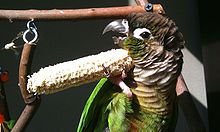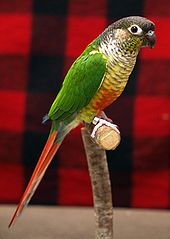- Green-cheeked Parakeet
-
Green-cheeked Parakeet 
Pyrrhura molinae molinae
at Kuala Lumpur Bird Park, MalaysiaConservation status Scientific classification Kingdom: Animalia Phylum: Chordata Class: Aves Order: Psittaciformes Family: Psittacidae Genus: Pyrrhura Species: P. molinae Binomial name Pyrrhura molinae
Massena & Souance, 1854
Approximate range. Now also confirmed for lined area[1] The Green-cheeked Conure (Pyrrhura molinae), is a small parrot of the genus Pyrrhura.They belong to several genera within a long-tailed group of the New World Parrot subfamily Arinae. The term "conure" is used primarily in bird keeping, though it has appeared in scientific journals.[2] It is native to forests of South America.
Contents
Description
The Green cheeked Conure is 26 cm (10 in) long and weighs 60 to 80 g. It is mainly green, with a brown/black/grey crown, white bare eye-rings, green cheeks, blue primary wing feathers, a grey beak, and its long pointed tail is mostly maroon. It has short transverse striations on its breast and a red abdominal area. Males and females have an identical external appearance.[3]
Taxonomy
The Green-cheeked Conure has six subspecies:[3][4]
- Pyrrhura molinae, (Massena & Souance 1854)
- P. m. australis, Todd 1915
- P. m. flavoptera, Maijer, Herzog, Kessler, Friggens & Fjeldsa 1998
- P. m. sordida,[3]
- P. m. molinae, (Massena & Souance 1854)
- P. m. phoenicura, (Schlegel 1864)
- P. m. restricta, Todd 1947
P. m. sordida naturally occurs as a green morph or as a yellow morph,[3] The yellow morph is also called the Yellow-sided Conure,[5] and was once erroneously considered to be a separate species, P. hypoxantha.[6]
The Green-cheeked Conure is similar to the Maroon-bellied Conure (P. frontalis),[5] and formerly there have been speculations that they were conspecific.[6] It is also similar in appearance to the Blaze-winged Conure and the Black-capped Conure.[5]
Distribution and habitat
The Green-cheeked Conure occurs in west-central and southern Mato Grosso, Brazil, through northern and eastern Bolivia to northwestern Argentina and northern Paraguay. Its habitat is forests and woodland, where it usually forms flocks of 10 to 20 individuals at treetop level, or larger flocks where there is plenty of food. Also a popular parrot pet for families and individuals.[5]
Behaviour
The Green-cheeked Conure eats various seeds and fruits and probably other kinds of vegetable matter. The average clutch is 4–6 eggs. Average incubation is 24 days, varying from 22 to 25 days. They have a less piercing squawk than Sun, Nanday or Jenday Conures and can easily learn tricks and (limited) speech.[citation needed]. Green cheeks have also been known to use tools (especially their own feathers for scratching hard to reach places).[citation needed]
Aviculture
Green-cheeked Conure are common in aviculture and are popular companion parrots. They are playful, affectionate and intelligent, known as having a "big personality in a small body". They can learn to talk, albeit with a limited vocabulary and a gravelly voice. They like to be held (although some like it more than others) and can learn tricks such as lying on their backs and "kissing." Along with other Pyrrhura Conures, they can be quite loud, therefore not making acceptable pets for apartment dwellers. They can be prone to biting, particularly when young, but an owner can cure this behavior with patience and time. They love fruits, (especially bananas and raisins), and seeds such as sunflower, safflower and hemp seeds; all things found in their natural environments. Green-cheeked Conure also love table food; they are flock animals and love to eat with their family. They can eat potatoes, carrots, corn, well cooked meat, bread, pasta, plain popcorn, and even eggs. A clipped and/or caged bird can become obese from eating too many fatty seeds such as sunflower seeds and peanuts. A bird-pellet diet with a calcium supplement will give them the proper nutrition, but should not be used exclusively due to the presence of trace chemical additives and bonding agents not found in the Conure's natural habitat.[citation needed] A good rule of thumb is 30% pellet diet, 10% seeds, and the rest being fresh foods- fruits, vegetables, or cooked food. Some Conures with health problems related to the kidneys[citation needed] should not be fed pellets. Green-cheeked Conures can live to 30 years with proper care, though the average lifespan is typically 10 years due to owner neglect.[7]
Colour mutations
In addition to the natural color forms, color mutants have been selectively bred in aviculture:
- Cinnamon are lime green and have a lighter, almost pale color to the feathers. The head is tan and the tail feathers are a lighter maroon than in normal Green-cheeked Conure.
- Yellow-Sided have a breast of bright colors.
- Pineapple is Cinnamon and Yellow-sided combination. They have a breast of bright colors, a tan head and lime green feathers on the back like a Cinnamon. The tail feathers are the same as a Yellow-sided showing a halo effect.
- Turquoise have a body with some blue-green and green feathers. The breast feathers are grayish and the tail feathers are gray.
There is also a green/red/blue apple mutation which is not very common but has been seen.
References
- ^ BirdLife International (2008). Pyrrhura molinae. In: IUCN 2008. IUCN Red List of Threatened Species. Downloaded on 29 July 2009.
- ^ for example: Buhrman-Deever, Susannah C.; Hobson, Elizabeth A.; Hobson, Aaron D. (2008). "Individual recognition and selective response to contact calls in foraging brown-throated conures, Aratinga pertinax". Animal Behaviour 76 (5): 1715. doi:10.1016/j.anbehav.2008.08.007.
- ^ a b c d Forshaw (2006). plate 85.
- ^ "Zoological Nomenclature Resource: Psittaciformes (Version 9.026)". www.zoonomen.net. 2009-07-26. http://www.zoonomen.net/avtax/psit.html.
- ^ a b c d Forshaw (2006). page 114.
- ^ a b Juniper; Parr (1998). Parrots: A Guide to Parrots of the World. p. 462. ISBN 0-300-07453-0.
- ^ "Green Cheeked Conure". Central Pets Educational Foundation. Web Archive Copy. http://web.archive.org/web/20080212044543/http://www.centralpets.com/animals/birds/parrots/prt1342.html.
Cited texts
- Forshaw, Joseph M. (2006). Parrots of the World; an Identification Guide. Illustrated by Frank Knight. Princeton University Press. ISBN 0691092516.
External links
- "Green Cheeked Conure". Parrot Encyclopedia. World Parrot Trust. http://www.parrots.org/index.php/encyclopedia/profile/green_cheeked_conure/.
- deVries, Lara (2000). "FAQ: Introduction to Green Cheeks". http://members.tripod.com/gcch/faq/faq1.html.
- Green Cheeked "Pyrrhura molinae". International Conure Association. http://www3.upatsix.com/ica/lexicon/greencheeked.htm Green Cheeked.
- "Internet Bird Collection". http://ibc.lynxeds.com.
- "Green-cheeked Conure photo gallery VIREO". The Academy of Natural Sciences. http://vireo.acnatsci.org/search.html?Form=Search&SEARCHBY=Scientific&KEYWORDS=pyrrhura+molinae&showwhat=images&AGE=All&SEX=All&ACT=All&Search=Search&VIEW=All&ORIENTATION=All&RESULTS=24.
Categories:- IUCN Red List least concern species
- Birds kept as pets
- Birds of Argentina
- Birds of Bolivia
- Birds of Brazil
- Birds of Paraguay
- Birds of the Pantanal
- Parrots
- Pyrrhura
- Pyrrhura molinae, (Massena & Souance 1854)
Wikimedia Foundation. 2010.






